If your team is disconnected, unmotivated, or just silently coasting, you’re already paying the price. This post is your guide to the upside: the benefits of employee engagement that show up in retention, productivity, morale, and actual business results.
There’s a reason “engagement” has become the workplace buzzword of the decade. And, it’s not just because people are still quitting in record numbers. It’s because engaged employees don’t just work harder. They care more. And when people care, it shows up in the metrics that matter: retention, productivity, innovation, customer experience, and yes…profit.
If you’re an internal comms or HR leader trying to figure out how to keep people connected in 2025, here’s the good news: you don’t have to reinvent the wheel. But you do need to make it roll more smoothly.
In this post, we’ll unpack the top 15 benefits of employee engagement, how to measure them, and why investing in your people’s connection to their work is one of the most strategic decisions your business can make.
Take a self-guided tour of ContactMonkey
See how our key features can streamline your internal communications.
Take product tour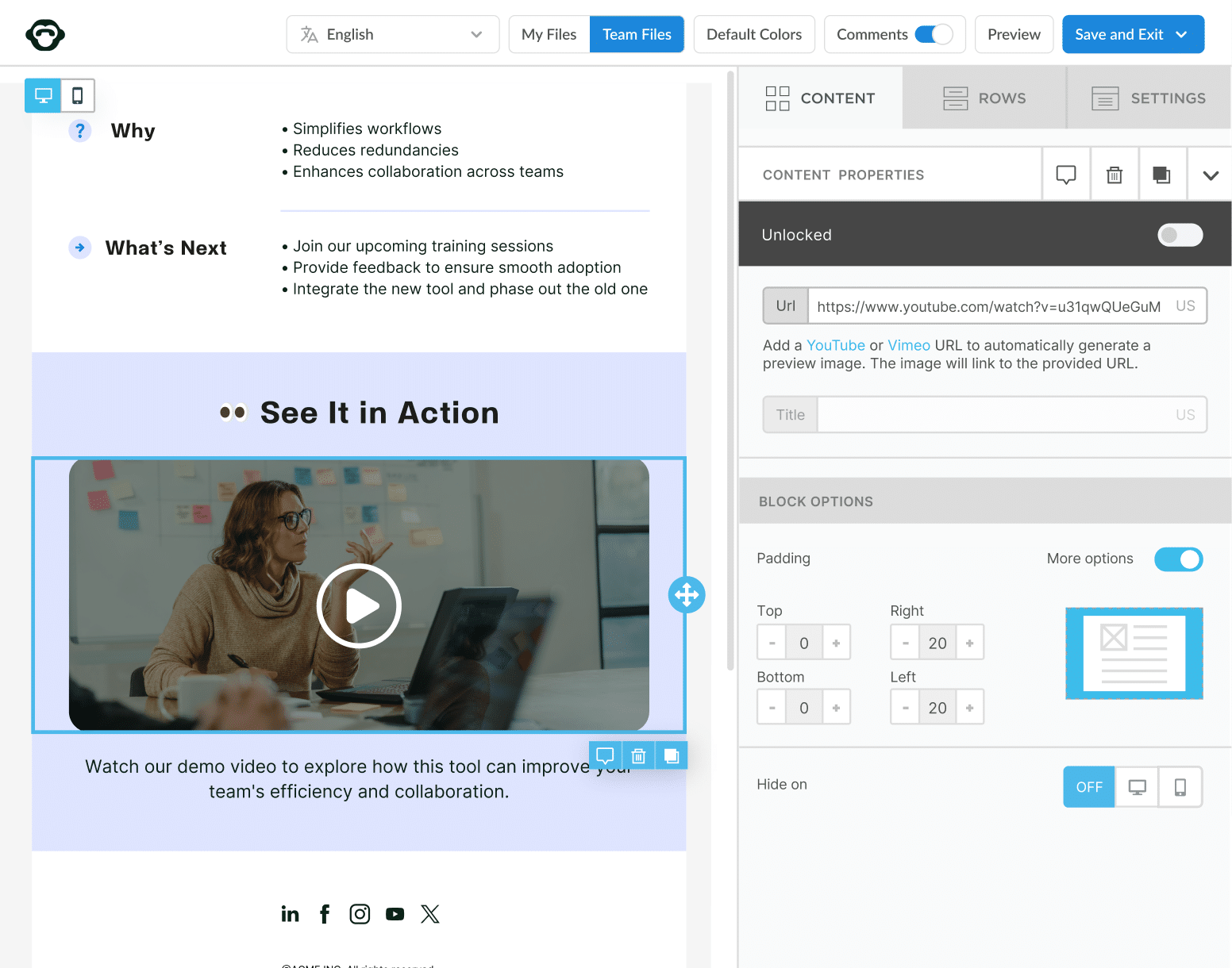
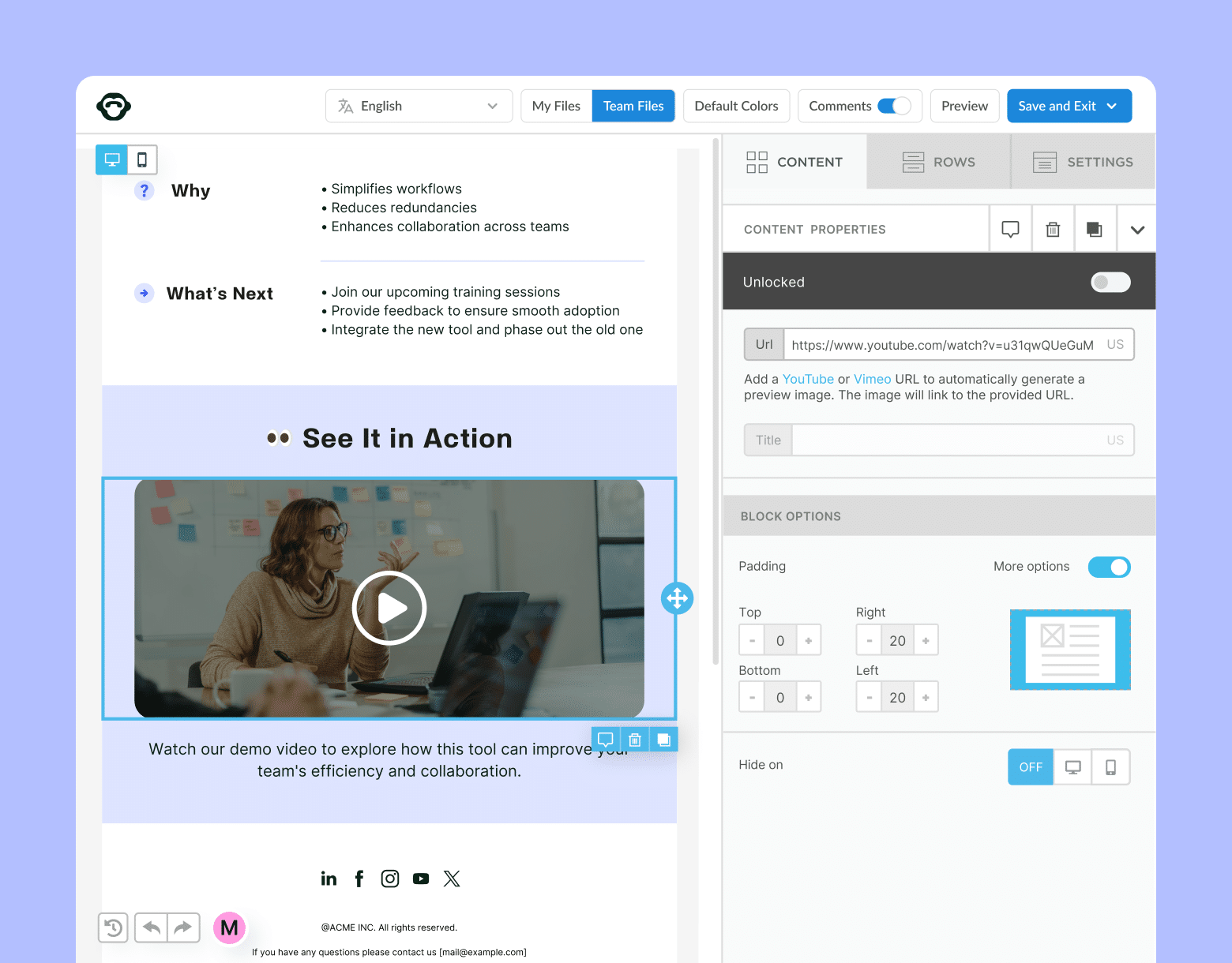
Why Is Employee Engagement So Important in 2025?
Employee engagement is important in 2025 because it directly impacts retention, performance, culture, and business growth. The workplace has changed, and engaged teams help organizations stay competitive and resilient.
Primary reasons to increase employee engagement:
- Boosts productivity and innovation: Engaged employees are more focused, motivated, and proactive, driving better business outcomes.
- Improves retention and reduces turnover: One of the top benefits of employee engagement is lower attrition, especially important in a flexible job market.
- Strengthens company culture and teamwork: The benefits of team engagement include better collaboration, stronger morale, and a sense of shared purpose.
- Enhances customer satisfaction: Engaged employees deliver better service, creating a ripple effect that improves the customer experience.
- Reduces burnout and absenteeism: One of the lesser-known advantages of employee engagement is improved employee well-being and fewer sick days.
- Increases profitability and performance: Gallup estimates that applying science-backed employee engagement strategies could unlock trillions of dollars in untapped economic value.
- Aligns employees with company goals: Engaged employees understand and support business objectives, helping teams move in the same direction.
Goals of an employee engagement strategy:
- Improve performance across teams and departments.
- Support career development and internal mobility.
- Promote inclusivity and employee recognition.
- Build emotional connection and long-term commitment.
- Enable data-driven decisions through tools like employee engagement surveys and employee engagement software.
Start two-way conversations and employee feedback loops
Learn how to engage staff with pulse surveys, content ratings and reactions, custom polls, and more. Ready to send modern emails?
See engagement features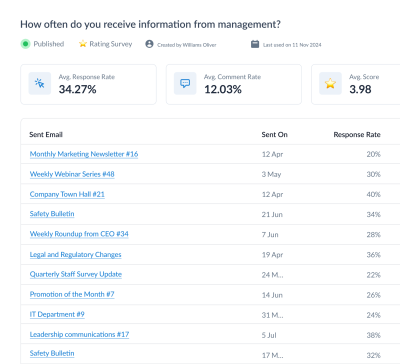
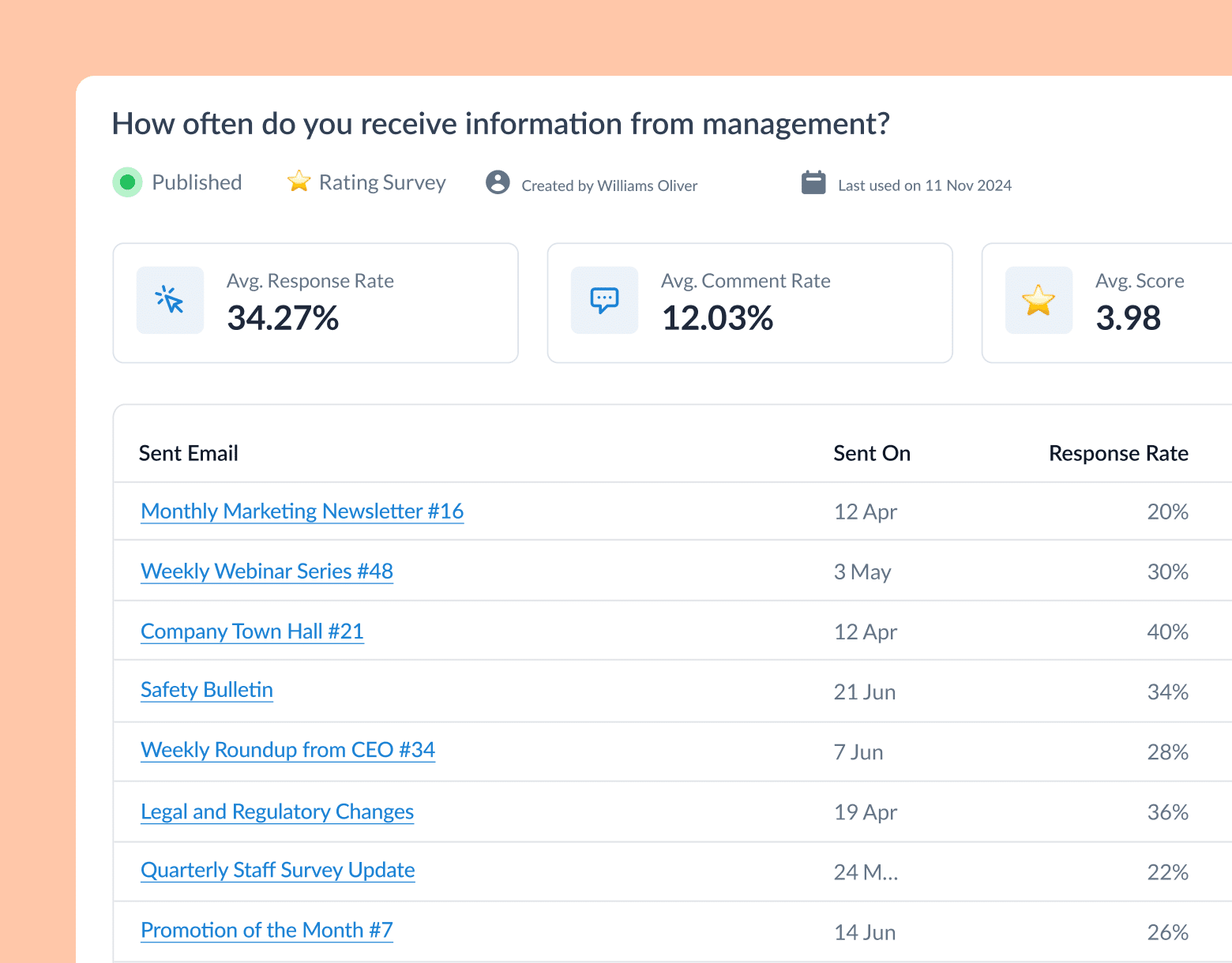
Top 15 Benefits of Increasing Employee Engagement
Below, we break down the top 15 benefits of engaged employees—not just for your company, but for your people, your customers, and your long-term growth. From productivity to purpose, these are the tangible and intangible advantages of employee engagement that internal comms and HR leaders need to prioritize this year.
1. Higher productivity and performance
One of the most immediate benefits of employee engagement is improved productivity. When employees are emotionally invested in their work, they take more ownership, meet deadlines faster, and contribute higher-quality output. It’s not about working more hours—it’s about showing up with purpose.
Why this is beneficial for employers: More productive teams move faster, achieve goals more efficiently, and drive consistent business growth. The advantages of employee engagement here are both operational and financial.
Why this is beneficial for employees: Engaged employees feel a sense of progress and impact, which boosts confidence and job satisfaction. They’re not just checking boxes, they’re contributing meaningfully.
How internal comms can activate this benefit: Internal communications teams can reinforce purpose by connecting individual work to larger company goals, sharing team wins, and spotlighting progress through personalized updates and employee newsletters. These are key employee engagement ideas that drive performance.
2. Lower turnover and stronger retention
A major reason companies are doubling down on engagement in 2025 deals with retention. One of the most powerful benefits of engaged employees is that they’re more likely to stay. When employees feel valued, heard, and supported, they’re not scrolling job boards on their lunch break.
Why this is beneficial for employers: Employee turnover is expensive—replacing someone can cost up to 2x their annual salary, according to Gallup. Reducing attrition means preserving knowledge, team cohesion, and customer relationships. It’s one of the most financially measurable advantages of employees.
Why this is beneficial for employees: Stability gives people space to grow. Employees who stay longer can build deeper relationships and explore new opportunities within the organization.
How internal comms can activate this benefit: Use feedback tools like an employee engagement survey to stay in tune with how people are feeling. Then follow up with action and communication that proves you’re listening.
3. Stronger company culture
The benefits of team engagement go beyond performance; they also shape culture. Engaged employees help create a workplace where people feel connected, aligned, and inspired. In 2025, culture is no longer a vibe—it’s a business asset.
Why this is beneficial for employers: A strong culture improves recruitment, retention, and reputation. It’s the backbone of a resilient, purpose-driven organization.
Why this is beneficial for employees: A thriving culture offers belonging. Employees want to feel like their work matters and that they’re part of something bigger than themselves.
How internal comms can activate this benefit: Use storytelling to bring company values to life. Reinforce culture in your channels every day, not just during onboarding. The benefits of employee engagement are clearest when culture is a lived experience.
4. Better customer experiences
Employees who feel connected to their work are more invested in customer outcomes. They respond faster, solve problems better, and treat every interaction like it matters—because it does.
Why this is beneficial for employers: High customer satisfaction leads to loyalty, repeat business, and positive reviews. Engaged teams consistently deliver better service, which impacts your brand long-term.
Why this is beneficial for employees: Knowing that their work directly affects customer happiness increases motivation and purpose. It becomes easier to take pride in the day-to-day.
How internal comms can activate this benefit: Share customer testimonials, reviews, and success stories with employees. Tie their work to real results. The benefits of engaged employees multiply when they see the impact they’re having on real people.
5. More innovation and creative problem-solving
Innovation thrives in engaged environments. When people feel safe, supported, and empowered, they’re more likely to think creatively and take smart risks. This is one of the most dynamic advantages of employee engagement—it unlocks potential that would otherwise go untapped.
Why this is beneficial for employers: Innovative teams build better products, solve problems faster, and adapt more quickly to market changes. The benefits of team engagement extend to cross-functional collaboration and new idea generation.
Why this is beneficial for employees: Creativity builds confidence. When employees are encouraged to think beyond their job descriptions, they find new ways to contribute and grow.
How internal comms can activate this benefit: Promote open feedback channels and employee idea programs. Use internal platforms to highlight innovation and celebrate fresh thinking. Tools like employee engagement software can help track participation and keep momentum going.
Unlock Internal Comms Superpowers
Discover why 10,000+ rely on us. See the internal email and employee newsletter platform in action.
Book demo

6. Improved collaboration and teamwork
When employees are engaged, they don’t just focus on their individual goals—they show up for each other. One of the most underrated benefits of team engagement is the way it improves collaboration across departments, roles, and locations. Engaged employees communicate better, trust more, and share knowledge freely.
Why this is beneficial for employers: Stronger collaboration leads to fewer silos, faster decision-making, and better project outcomes. The advantages of employee engagement show up in everything from smoother workflows to stronger cross-functional alignment.
Why this is beneficial for employees: When teams are connected, work feels less isolating and more supportive. People are more likely to ask for help, offer feedback, and celebrate each other’s wins.
How internal comms can activate this benefit: Highlight collaborative wins and cross-departmental projects. Use newsletters and digital channels to model transparent communication and teamwork in action. A well-crafted employee engagement survey can help identify where collaboration is lagging.
7. Fewer absences and lower burnout
One of the quieter but critical benefits of engaged employees is reduced absenteeism. People who are connected to their work are less likely to call in sick, feel overwhelmed, or experience burnout. They’re also better able to manage stress and more willing to reach out when they need support.
Why this is beneficial for employers Fewer absences mean more consistency, better planning, and less disruption to team performance. It’s a key operational benefit of employee engagement that helps leaders maintain momentum.
Why this is beneficial for employees: Employees who feel supported are healthier, happier, and more resilient. They know when to take breaks, ask for resources, and prioritize balance.
How internal comms can activate this benefit: Promote wellness programs, encourage time off, and normalize conversations about mental health. Use campaigns and manager toolkits to foster a culture of care.
8. Faster adoption of change
In times of change—whether it’s a reorg, tech rollout, or leadership shift—the advantages of employee engagement become crystal clear. Engaged employees are more adaptable because they trust leadership, understand the why behind the change, and feel equipped to move forward.
Why this is beneficial for employers: Change efforts succeed faster and with less resistance. Teams stay aligned, focused, and positive—even when things are uncertain.
Why this is beneficial for employees: Engaged employees feel informed and included in the process. They’re more likely to feel a sense of control and less likely to be overwhelmed by change.
How internal comms can activate this benefit: Build a change communication plan that explains the “why,” outlines clear next steps, and offers two-way feedback. Keep communication transparent, frequent, and human.
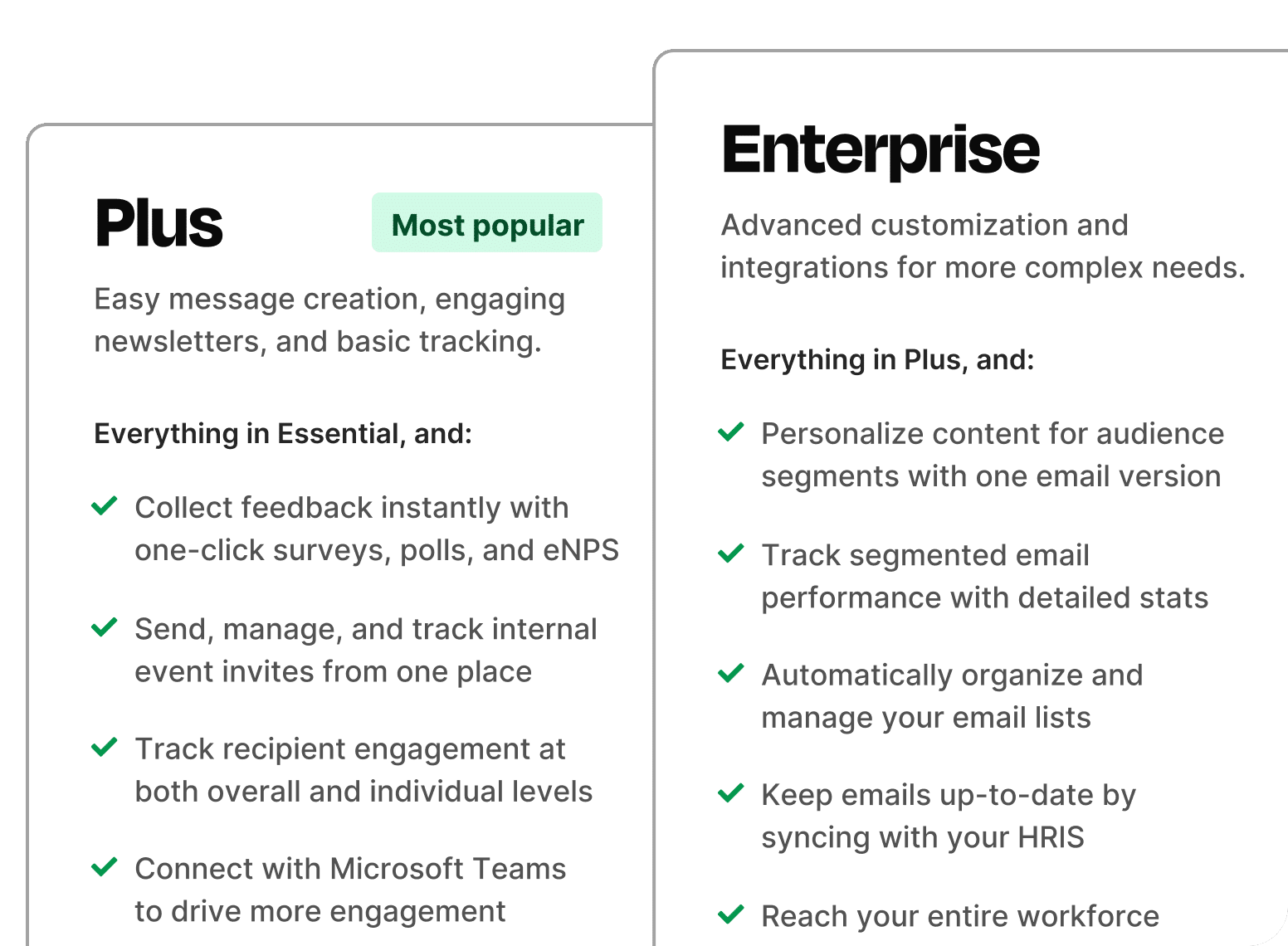
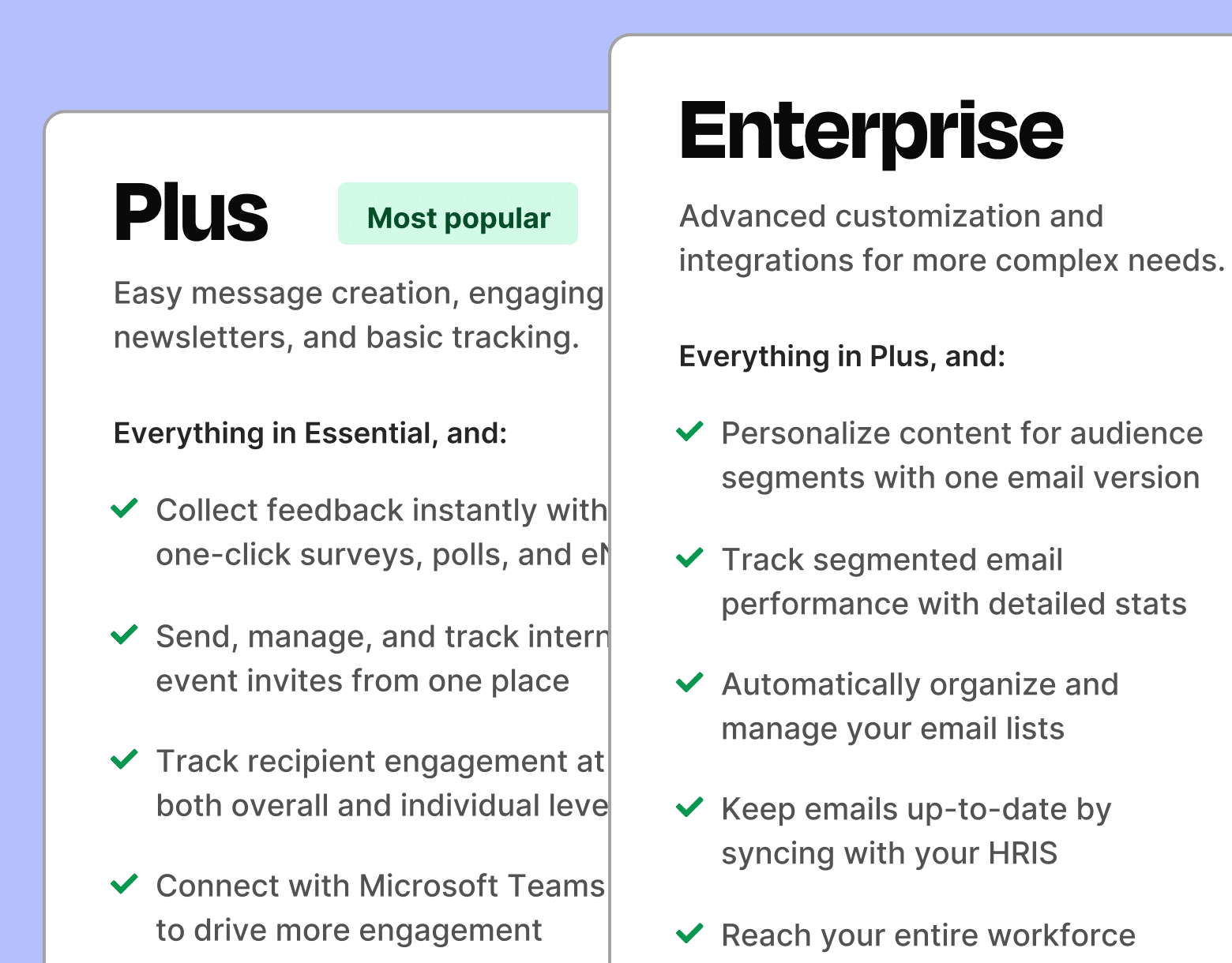
9. More accountability and ownership
One of the most empowering benefits of employee engagement is the sense of ownership it creates. Engaged employees don’t need to be micromanaged—they hold themselves accountable because they care about the outcome.
Why this is beneficial for employers: Higher accountability leads to stronger results, fewer mistakes, and better decision-making at every level of the organization.
Why this is beneficial for employees: Ownership fosters autonomy and pride. When employees feel trusted, they rise to the occasion and become more invested in their success.
How internal comms can activate this benefit: Clearly communicate roles, expectations, and outcomes. Use storytelling to show how individual contributions connect to business goals. This clarity is essential to unlocking the full benefits of team engagement.
10. Increased alignment with company goals
Engaged employees understand the mission. They don’t just memorize the vision statement—they internalize it. That’s one of the most strategic benefits of employee engagement in 2025: alignment. When people know where the company is going, they’re more focused and effective in getting there.
Why this is beneficial for employers: Teams that align with leadership objectives perform better, innovate smarter, and stay focused on high-impact work.
Why this is beneficial for employees: Employees feel connected to something bigger than their to-do list. That connection creates meaning and boosts motivation.
How internal comms can activate this benefit: Use consistent messaging across all channels to reinforce strategic priorities. Share updates from leadership and make space for employees to ask questions and offer feedback.
11. Stronger leadership trust
Another important benefit of employee engagement is the trust it builds between employees and executives. When employees feel informed, heard, and included, trust grows. When trust grows, performance follows.
Why this is beneficial for employers: Teams that trust their leaders are more loyal, more aligned, and more resilient during challenges or change.
Why this is beneficial for employees: Trust creates psychological safety. Employees feel more confident in voicing opinions, suggesting improvements, or admitting mistakes—leading to stronger collaboration.
How internal comms can activate this benefit: Elevate leadership visibility. Use town halls, video messages, and transparent updates to build open communication between executives and staff. Engagement grows when leadership feels human and accessible.
Take a self-guided tour of ContactMonkey
See how our key features can streamline your internal communications.
Take product tour

12. Better internal communication
One of the most immediate benefits of team engagement is more effective communication. Engaged employees don’t just absorb information—they interact with it, respond to it, and share it. This creates a two-way flow of feedback that builds clarity and cohesion across the organization.
Why this is beneficial for employers: Clear communication improves decision-making, reduces confusion, and strengthens cross-team alignment.
Why this is beneficial for employees: Employees stay informed, feel heard, and understand how their work fits into the big picture. This makes everyday tasks feel more purposeful.
How internal comms can activate this benefit: Use segmented updates, personalized email campaigns, and interactive formats powered by employee engagement software to ensure employees receive relevant, actionable information. Strong communication is a foundation for engagement.
13. Improved employee advocacy
Engaged employees are more likely to become advocates for your brand. They recommend your company to peers, refer talent, and share positive experiences on social media or review platforms.
Why this is beneficial for employers: Employee advocacy strengthens employer branding, improves talent attraction, and boosts credibility with customers and partners.
Why this is beneficial for employees: Advocacy reflects pride. Employees who feel engaged are proud to associate their personal brand with your organization.
How internal comms can activate this benefit: Run employee spotlight campaigns, share internal wins externally, and encourage sharing through branded content or ambassador programs. Combine this with feedback from employee engagement survey questions to fine-tune your message.
14. Enhanced career development and growth
A motivating advantage of employee engagement is the focus it brings to professional development. Engaged employees are eager to grow, and organizations that invest in their growth see stronger performance, loyalty, and leadership pipelines.
Why this is beneficial for employers: Internal mobility improves succession planning and reduces the cost of external hiring. It also fuels innovation and knowledge sharing.
Why this is beneficial for employees: Growth opportunities make employees feel valued and invested in. They’re more likely to stay when they see a clear path forward.
How internal comms can activate this benefit: Promote available development programs, learning resources, and internal job postings. Use stories and testimonials to show how employees have advanced their careers within the company.
Get powerful email analytics and reporting features
Know exactly who is opening and engaging with your employee communications and company newsletters.
Explore analytics & reporting
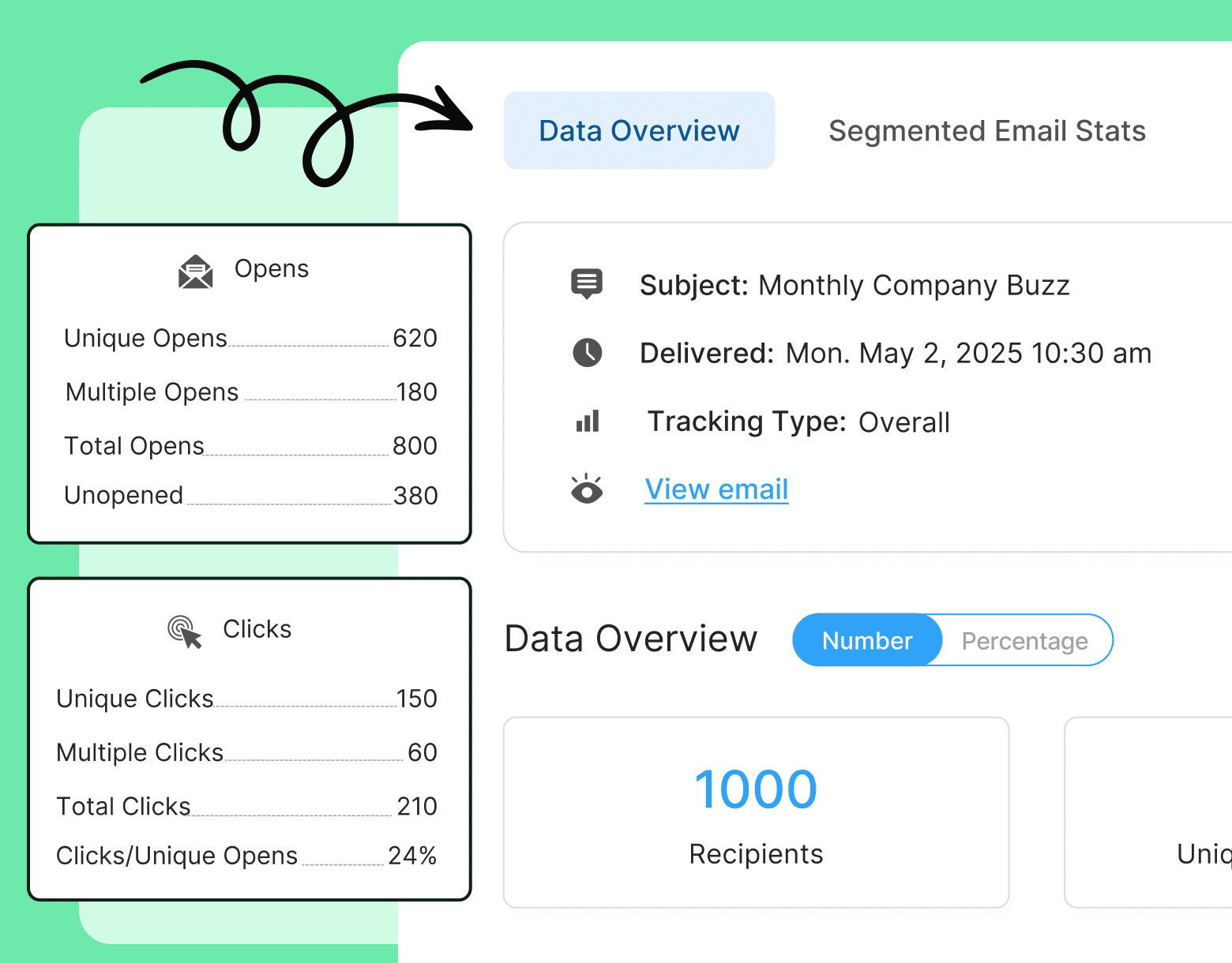
15. Measurable business impact
Ultimately, the greatest of all benefits of employee engagement is this: it drives measurable business results. From higher revenue to stronger customer satisfaction to improved employee retention, the data below speaks for itself.
Why this is beneficial for employers: Gallup’s meta-analysis reveals that highly engaged teams significantly outperform disengaged ones across key business metrics. They see:
- 81% lower absenteeism
- 43% lower turnover in low-turnover organizations
- 23% higher profitability
- 18% greater productivity
Why this is beneficial for employees: When employees are engaged, work feels meaningful. They understand how their role contributes to the bigger picture, feel recognized for their efforts, and know their voice matters. This sense of purpose and connection fuels motivation, loyalty, and a deeper commitment to their work and their team.
How internal comms can activate this benefit: Use pulse surveys and employee feedback loops to surface insights. Share outcomes transparently and spotlight where feedback has shaped decisions. Strategic communication turns engagement into action—and proves its value.
How to Increase Employee Engagement
You don’t need unlimited resources to increase employee engagement. You need the right software, intention, consistency, and a clear understanding of what your people actually value.
The most effective ways to increase employee engagement in 2025 are simple, scalable, and human-first.
- Start with regular feedback: Use tools like an employee engagement survey to understand what’s working—and what’s not.
- Recognize great work in real time: Public recognition is one of the most underrated benefits of employee engagement and a proven way to boost morale.
- Communicate with purpose: Use personalized updates, segmented messages, and two-way channels to build trust and transparency.
- Support career growth: The advantages of employee engagement are amplified when employees can see a future for themselves at your organization.
- Make managers engagement champions: They’re the link between strategy and daily experience.
BONUS: Want a full breakdown of proven strategies? Explore how to improve employee engagement step-by-step and more articles on this topic by visiting our blog.
How to Measure Employee Engagement
When it comes to measurement, gut feelings aren’t enough. The best companies use a mix of qualitative and quantitative methods to track the real-time pulse of their teams.
Here are the top ways to measure employee engagement in 2025:
- Employee engagement surveys: Use targeted survey questions to gauge satisfaction, motivation, and alignment across your workforce.
- Pulse surveys: Short, frequent check-ins help monitor engagement trends and spot issues early.
- Employee engagement software: Tools that track open rates, feedback loops, and participation in internal campaigns can reveal how engaged your team truly is.
- Turnover and retention data: High engagement usually correlates with higher retention.
- Participation in programs: Low involvement in initiatives may signal deeper disengagement.
These employee engagement metrics help you quantify the benefits of employee engagement and identify the areas that need attention.
BONUS: Learn how to measure employee engagement effectively with this step-by-step guide.
Employee Engagement Trends and Challenges for 2025
Employee engagement in 2025 is evolving—and fast. While the benefits of employee engagement remain as strong as ever, the path to achieving them looks different than it did even a year ago.
Here are a few trends internal comms and HR leaders need to watch:
Trend: personalized communication is the new standard
Mass emails aren’t enough. Employees expect targeted, relevant messaging that speaks to their role, location, and interests. Smart segmentation and dynamic content tools—often built into modern employee engagement software—are becoming essential.
Trend: feedback is continuous, not quarterly
The most engaged companies use real-time employee engagement survey tools and pulse checks to stay ahead of issues. Continuous feedback loops are replacing once-a-year check-ins.
Trend: culture and engagement are co-created
In 2025, employees want to shape the culture they’re part of. One of the biggest advantages of employee engagement is how it empowers people to contribute ideas, drive initiatives, and influence company values.
Now, the challenges:
Challenge: Engagement is harder in hybrid workplaces
Without consistent face time, employees can feel isolated or disconnected. The benefits of team engagement depend on leaders creating intentional opportunities for connection.
Challenge: Burnout and change fatigue are real
Between economic uncertainty and constant change, it’s harder than ever to keep teams motivated. Internal comms teams must balance transparency with empathy to maintain trust.
Challenge: Proving ROI to leadership
Many leaders still see engagement as intangible. That’s why measuring and communicating the benefits of engaged employees—from retention to innovation—is key to gaining long-term buy-in.
As the landscape shifts, one thing is clear: the future belongs to companies that treat employee engagement as a strategic advantage, not just a simple task.
Ready to Turn Engagement Into Impact?
Employee engagement initiatives are measurable, repeatable, and transformational when done right. But, you need the right tools to make it happen.
ContactMonkey helps internal comms and HR teams bring engagement strategies to life, quickly, easily, and with impact.
Here’s how:
- Email Template Builder Feature: Create stunning, personalized internal emails in minutes—no designers required. Easily embed videos, images, links, and updates that keep people reading.
- Employee Feedback Features: Gather real-time input directly in Outlook or Gmail. Ask meaningful employee engagement survey questions without sending people to an external platform.
- Analytics Dashboard Feature: See what’s working with real-time insights into open rates, click rates, read time, and engagement by department. Prove the ROI of your campaigns with data.
- List Management Feature: Send the right message to the right audience. Whether you’re targeting new hires, remote teams, or frontline workers, ContactMonkey helps tailor every send.
- Two-way communication: Let employees respond to updates, share ideas, and interact directly within your emails. Engagement starts with conversation.
Take the next step and see how internal comms can become your organization’s competitive edge. All you have to do is book a 15-minute call with our team to see the platform in action!




